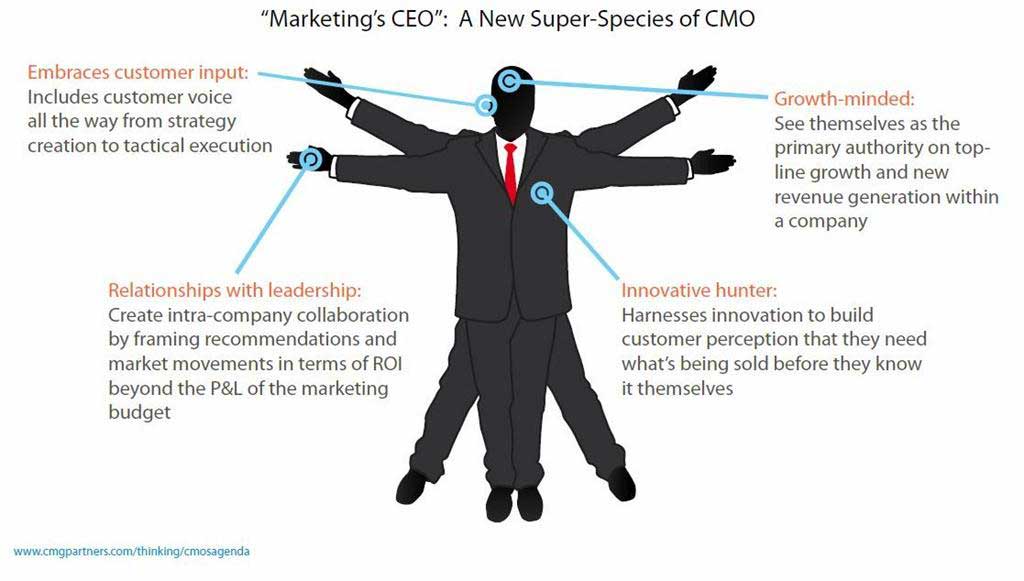Over the past year, chief marketing officers (CMOs) have stepped up their game by shouldering greater responsibility for the conversion of a key business asset—a company's marketing capacity—into top-line and bottom-line results.
Once focused on defending their turf and justifying their domain, CMOs have evolved and now drive business value. As a result of that evolution, CMOs have morphed into a marketing "super-species": Marketing's CEO.
The New CMO
Each year, CMG Partners, my firm, embarks on a research initiative—The CMOs Agenda, featuring in-depth interviews with CMOs and lead marketers from midsize and Fortune 500 companies across multiple industries. The objective is to learn about and publish the trends and challenges confronting today's CMOS.
This year's study found that similar to CEOs, lead marketers are increasingly engaged in setting a longer-term vision for Marketing to generate greater enterprise value. In addition, lead marketers are assessing ways to dramatically benefit from the assets they are responsible for.

Marketing's CEO is more than a new label. It goes far beyond simply minding the marketing function (once seen as solely marcom and brand management). Marketing's CEO is a leader focused on growth and an invaluable ally to the company's CEO.
That evolution is the result of a changing environment teeming with challenge and complexity. Charged with the "simple task" of harnessing the power of unpredictable consumer and competitor behaviors, CMOs must navigate through a myriad of internal stakeholders and gatekeepers. Their success requires that they balance and capitalize on the intersection of market opportunity and corporate direction.
For Marketing's CEO, relying on historical precedent won't cut it. Getting up-to-speed on the latest marketing tools and trends isn't enough. Forging new and stronger internal alliances is inadequate.
If Marketing's CEO is to thrive, this "super-species" must act like any new species: It must embrace advanced survival principles.
Survival Guide for Marketing's CEO
1. Conquer environmental complexity
The collision of global, economic, and technological shifts means massive disruption for CMOs. In this new era of shared control over brand value and relevance with customers, prospects, and the anonymous digital world, CMOs must work even harder to identify the opportunities and risks for their enterprise. The truth is... disruptions can offer the savvy CMO a unique opportunity to steal a march on the competition in a dynamic and crowded marketplace.
2. Get your mind right
The super-species must view its role beyond advertising or brand stewardship. As lead marketers, Marketing CEOs must see themselves and act as primary authority figures on top-line growth and new-revenue generation within a company.
They know the marketplace better than anyone in the organization, and they have the tools to make use of conventional and unconventional wisdom. As businesses enter new markets or segments, expand geographically or demographically, or search for new revenue from customers, CMOs must think of themselves as the CEO who's on the hook for real growth.
3. Don't go it alone
The social media phenomenon has created a powerful voice for customers, prospects, critics, and observers. Accordingly, Marketing's CEO has learned to either work within the fabric of her brand's social media dialogue... or face failure.
Consider two contrasting examples from the same industry: The Gap, a retailer with a large and active online customer base, had to retreat from a logo refresh after the fact because of the backlash it faced from its online community. Meanwhile, JCPenney, which included its customers and fans in its brand refresh up front, garnered approval and facilitated a hugely productive dialogue about its rebranding efforts.
So, what's the secret to navigating the new marketing landscape that has been forever changed by the social dialogue? According to the evolved marketing playbook, you've got to stack your team with the necessary sub-species—millennials. That demographic has been trained, practically since birth, in the ways of social media. Effectively tapped, millennials can be the Marketing CEO's secret weapon in shaping marketplace perception via digital mediums.
4. Hunt creatively
Creating an appetite among consumers for a product or service—and shaping perceptions accordingly—is essential for real growth. CMOs must build the perception among customers that they need a specific product before customers themselves know it.
By creating a higher level of need, the CMO becomes a crucial voice for innovation at an organization. Establishing Marketing's role as the best steward of innovation is worth a CMO's time and energy.
5. Interpret the native language
Just as CMOs rely on external stakeholders to flourish, they also depend on cooperation within their colony. CMOs must deliver their recommendations (in terms of strategic impact and cost-benefit) as a prerequisite for credibility with their alpha—the CEO.
Moreover, Marketing's CEO must build relationships with other fellow senior managers, and also create intra-company collaboration by understanding market movements framed in terms of return on investment (ROI), share gain, and shareholder value. Educating and encouraging neighboring tribes such as Operations, Sales, and Product Development to value how Marketing can affect growth and business performance will yield helpful allies for Marketing's CEO.
* * *
Today's successful CMOs share various traits that make them, collectively, a marketing super-species. They know how to drive organic, top-line growth by maximizing use of the tools at their disposal. They see themselves as business leaders, taking a business perspective on marketing-asset utilization. They evangelize innovation. And they adroitly bridge the increasingly complex marketplace (with its unbounded social media layering) and the increasingly demanding internal corporate environment.
In short, successful CMOs have become Marketing's CEO.



